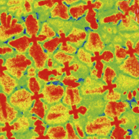Crossref Citations
This article has been cited by the following publications. This list is generated based on data provided by
Crossref.
Pollock, Tresa M.
and
Van der Ven, Anton
2019.
The evolving landscape for alloy design.
MRS Bulletin,
Vol. 44,
Issue. 4,
p.
238.
Sun, Ruoshi
Asta, Mark
and
van de Walle, Axel
2019.
First-principles thermal compatibility between Ru-based Re-substitute alloys and Ir coatings.
Computational Materials Science,
Vol. 170,
Issue. ,
p.
109199.
Aggour, Kareem S.
Gupta, Vipul K.
Ruscitto, Daniel
Ajdelsztajn, Leonardo
Bian, Xiao
Brosnan, Kristen H.
Chennimalai Kumar, Natarajan
Dheeradhada, Voramon
Hanlon, Timothy
Iyer, Naresh
Karandikar, Jaydeep
Li, Peng
Moitra, Abha
Reimann, Johan
Robinson, Dean M.
Santamaria-Pang, Alberto
Shen, Chen
Soare, Monica A.
Sun, Changjie
Suzuki, Akane
Venkataramana, Raju
and
Vinciquerra, Joseph
2019.
Artificial intelligence/machine learning in manufacturing and inspection: A GE perspective.
MRS Bulletin,
Vol. 44,
Issue. 7,
p.
545.
Yu, Zhigang
Leng, Haiyan
Luo, Qun
Zhang, Jieyu
Wu, Xiaochun
and
Chou, Kuo-Chih
2020.
New insights into ternary geometrical models for material design.
Materials & Design,
Vol. 192,
Issue. ,
p.
108778.
Chennimalai Kumar, Natarajan
Zhang, Yiming
Gupta, Vipul
Dheeradhada, Voramon
Dial, Laura
Khan, Genghis
Vinciquerra, Anthony
and
Wang, Liping
2020.
Applications of Intelligent Experimental Design for Additive Manufacturing.
Ayyasamy, Mukil V.
Deijkers, Jeroen A.
Wadley, Haydn N.G.
and
Balachandran, Prasanna V.
2020.
Density functional theory and machine learning guided search for RE2Si2O7 with targeted coefficient of thermal expansion.
Journal of the American Ceramic Society,
Vol. 103,
Issue. 8,
p.
4489.
Li, Jiaheng
Zhang, Yingbo
Cao, Xinyu
Zeng, Qi
Zhuang, Ye
Qian, Xiaoying
and
Chen, Hui
2020.
Accelerated discovery of high-strength aluminum alloys by machine learning.
Communications Materials,
Vol. 1,
Issue. 1,
Ghosh, Sayan
Meshkov, Andrey I.
Gupta, Vipul
Pandita, Piyush
Zhang, Yiming
and
Wang, Liping
2021.
Uncertainty Quantification of Mesoscale Melt-Pool Model for Powder Bed Fusion Additive Manufacturing of Metals.
Zhang, Yiming
Karnati, Sreekar
Nag, Soumya
Johnson, Neil
Khan, Genghis
and
Ribic, Brandon
2022.
Accelerating Additive Design With Probabilistic Machine Learning.
ASCE-ASME Journal of Risk and Uncertainty in Engineering Systems, Part B: Mechanical Engineering,
Vol. 8,
Issue. 1,
Singh, Varshika
Patra, Santanu
Murugan, Natarajan Arul
Toncu, Dana-Cristina
and
Tiwari, Ashutosh
2022.
Recent trends in computational tools and data-driven modeling for advanced materials.
Materials Advances,
Vol. 3,
Issue. 10,
p.
4069.
Han, Hongyong
Li, Wendao
Antonov, Stoichko
and
Li, Longfei
2022.
Mapping the creep life of nickel-based SX superalloys in a large compositional space by a two-model linkage machine learning method.
Computational Materials Science,
Vol. 205,
Issue. ,
p.
111229.
Nandal, Vickey
Dieb, Sae
Bulgarevich, Dmitry S.
Osada, Toshio
Koyama, Toshiyuki
Minamoto, Satoshi
and
Demura, Masahiko
2023.
Artificial intelligence inspired design of non-isothermal aging for γ–γ′ two-phase, Ni–Al alloys.
Scientific Reports,
Vol. 13,
Issue. 1,
Hu, Mingwei
Tan, Qiyang
Knibbe, Ruth
Xu, Miao
Jiang, Bin
Wang, Sen
Li, Xue
and
Zhang, Ming-Xing
2023.
Recent applications of machine learning in alloy design: A review.
Materials Science and Engineering: R: Reports,
Vol. 155,
Issue. ,
p.
100746.
Amos, P. G. Kubendran
2023.
Advances in Processing of Lightweight Metal Alloys and Composites.
p.
3.
2023.
Computational Design of Engineering Materials.
p.
323.
Aggour, Kareem S.
Kumar, Vijay S.
Gupta, Vipul K.
Gabaldon, Alfredo
Cuddihy, Paul
and
Mulwad, Varish
2024.
Semantics-Enabled Data Federation: Bringing Materials Scientists Closer to FAIR Data.
Integrating Materials and Manufacturing Innovation,
Vol. 13,
Issue. 2,
p.
420.
Fu, Jiabo
Yang, Quanling
Devojno, Oleg
Kardapolava, Marharyta
Kasiakova, Iryna
and
Wang, Chenchong
2024.
Wear Resistance Design of Laser Cladding Ni-Based Self-Fluxing Alloy Coating Using Machine Learning.
Materials,
Vol. 17,
Issue. 22,
p.
5651.
Wenga, Terrence
Macdonald, Digby D.
and
Ma, Wenchao
2025.
Multi-scale computational study of high-temperature corrosion and the design of corrosion-resistant alloys.
Progress in Materials Science,
Vol. 148,
Issue. ,
p.
101359.
Rabbitt, Daisy
Villapún, Victor M.
Carter, Luke N.
Man, Kenny
Lowther, Morgan
O'Kelly, Paraic
Knowles, Alexander J.
Mottura, Alessandro
Tang, Yuanbo T.
Luerti, Lorenzo
Reed, Roger C.
and
Cox, Sophie C.
2025.
Rethinking Biomedical Titanium Alloy Design: A Review of Challenges from Biological and Manufacturing Perspectives.
Advanced Healthcare Materials,
Vol. 14,
Issue. 4,



